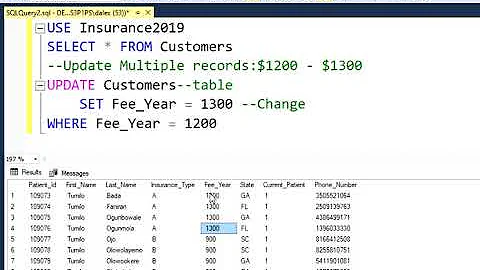SQL Database multiple values for same attribute - Best practices?
I think this is rather n:m-related. You'd need one table Person holding ID, name and other person's details. Another table Accessory with ID, name and more accessory's details. And a third table PersonAccessory to store pairs of PersonID and AccessoryID (this is called mapping table)
Working example (SQL-Server syntax)
CREATE TABLE Person(ID INT IDENTITY PRIMARY KEY,Name VARCHAR(100));
INSERT INTO Person VALUES('John'),('Jim');
CREATE TABLE Accessory(ID INT IDENTITY PRIMARY KEY,Name VARCHAR(100));
INSERT INTO Accessory VALUES('Scarf'),('Mask');
CREATE TABLE PersonAccessory(PersonID INT NOT NULL FOREIGN KEY REFERENCES Person(ID)
,AccessoryID INT NOT NULL FOREIGN KEY REFERENCES Accessory(ID));
INSERT INTO PersonAccessory VALUES(1,1),(2,1),(2,2);
SELECT p.Name
,a.Name
FROM PersonAccessory AS pa
INNER JOIN Person AS p ON pa.PersonID=p.ID
INNER JOIN Accessory AS a ON pa.AccessoryID=a.ID;
GO
--DROP TABLE PersonAccessory;
--DROP TABLE Accessory;
--DROP TABLE Person
The result
John Scarf
Jim Scarf
Jim Mask
Related videos on Youtube
Norbert Forgacs
I work as a Software System Test Engineer/Tool Developer. I finished my Bachelor's Degree at The Faculty of Automatic Control and Computer Science, in Timisoara. I am enthusiast to learn new things everyday!
Updated on June 04, 2022Comments
-
 Norbert Forgacs almost 2 years
Norbert Forgacs almost 2 yearsI have found myself that some attributes from my Person table, need to hold multiple values/choices, which is not a good SQL practice so I created a second table, like this:
Before:
Person table -ID (ex. 101) -Name (ex. John) -Accessories (ex. Scarf, Mask, Headband, etc..) - One person can have a combination of thisAfter:
Person Table -ID -Name PersonDetails Table -PersonID (FK to Person table) -Attribute type -Attribute valueand an example:
Person: ID:13; Name: John Snow PersonDetails: PersonID: 13; Attribute type: Accessories; Attribute value: Scarf PersonID: 13; Attribute type: Accessories; Attribute value: MaskYou can see that person with ID 13 has both Scarf and Mask.
Is this a good practice? What other ways are there to do this the most efficiently?
Also, what ways are there if an update comes up and Person with 13 doesn't have Scarf and Mask but only Glasses? (Delete the 2 separately and insert a new one? that means 3 queries for only one modify request)
-
Gordon Linoff about 7 yearsWhat you have done is generally the best practice. Under some circumstances, storing the list as JSON, XML, array, or nested table might be appropriate. However, a separate table for the 1-n relationship is the SQLish way of storing the data.
-
 Shnugo about 7 years@GordonLinoff Really?
Shnugo about 7 years@GordonLinoff Really? -
 a_horse_with_no_name about 7 yearsThis is known as the anti-pattern "Entity-Attribute-Value" (search for it). In Postgres I would use a
a_horse_with_no_name about 7 yearsThis is known as the anti-pattern "Entity-Attribute-Value" (search for it). In Postgres I would use ahstorecolumn for that. In other DBMS you might store those key/value pairs as JSON as Gordon mentioned
-
-
 Norbert Forgacs about 7 yearsAnd what will you decide if for example Jim wasn't really wearing a Mask and a Scarf, but only a pair of glasses?
Norbert Forgacs about 7 yearsAnd what will you decide if for example Jim wasn't really wearing a Mask and a Scarf, but only a pair of glasses? -
 Shnugo about 7 years@ForgacsNorbert Just add the pair of glasses as new item to the table
Shnugo about 7 years@ForgacsNorbert Just add the pair of glasses as new item to the tableAccessory, remove the two entries for Jim and add a pair of Jim's ID and the glasses' ID... -
 Shnugo about 7 years@ForgacsNorbert To answer your comment from above that means 3 queries for only one modify request): No, this is not one modify request but actually two or even three of them (remove some items, add glasses)
Shnugo about 7 years@ForgacsNorbert To answer your comment from above that means 3 queries for only one modify request): No, this is not one modify request but actually two or even three of them (remove some items, add glasses) -
 Norbert Forgacs about 7 yearsso a simple DELETE * from PersonAccessory WHERE ... and Insert into PersonAccessory will do. Thanks!
Norbert Forgacs about 7 yearsso a simple DELETE * from PersonAccessory WHERE ... and Insert into PersonAccessory will do. Thanks! -
 Norbert Forgacs about 7 yearsIt's a bit hard for me to understand the logic behind without any further explanations
Norbert Forgacs about 7 yearsIt's a bit hard for me to understand the logic behind without any further explanations -
 Rahul about 7 yearsHi @ForgacsNorbert please read about STUFF sql function here msdn.microsoft.com/en-us/library/ms188043.aspx & CHARINDEX sql function here msdn.microsoft.com/en-IN/library/ms186323.aspx
Rahul about 7 yearsHi @ForgacsNorbert please read about STUFF sql function here msdn.microsoft.com/en-us/library/ms188043.aspx & CHARINDEX sql function here msdn.microsoft.com/en-IN/library/ms186323.aspx





